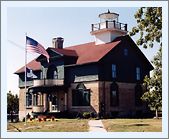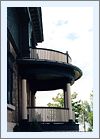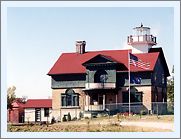|
Historical
Information

At the dawn of the
third decade of the nineteenth century, Crawfordsville visionary Major
Isaac C. Elston visited Indiana's small sliver of frontage on Lake
Michigan, and foreseeing the potential the area represented as a
shipping point for Indiana's bounty, purchased most of the land and
platted the town of Michigan City on the banks of Trail Creek. Nestled
between twin sand dunes known as Yankee Slide and Hoosier Slides,
shifting sands from the two huge dunes blew into the river mouth,
barring entry to all but vessels of the shallowest draft. Thus, vessels
arriving at the river mouth were forced to anchor offshore, with their
cargoes transferred to and from the waiting vessels by shallow draft
scows known as lighters.
By 1834, the village had grown to
include a tannery, blacksmith shop, tinsmith, brick kiln, four grocery
stores, three taverns five general stores, two hotels, a bank and an
Episcopalian church. Seeking federal assistance in opening up the river
to an increasing number of vessels, Elston solicited the assistance of
Indiana Senator John Tipton, who presented a motion before the Senate on
January 2, 1834 requesting funding for establishing a port of delivery
and a lighthouse at the river mouth. Seeking additional input on the
matter, the matter was forwarded to the Committee of Commerce for
further evaluation and recommendation. Convinced of the validity of his
requested improvements, and as an incentive to the Government to move on
Tipton's proposal before the Senate, Elston shrewdly deeded a tract of
land from the first bend of the river to the lakeshore to the Federal
Government on June 23, 1835 to serve as a site for the erection of the
new lighthouse for which he was convinced an appropriation would be
forthcoming.
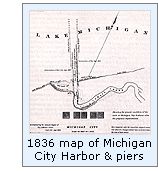 July 4, 1836 was a banner day for
Elston and the citizens of Michigan City, for it marked both the date on
which the town was officially incorporated and the date on which it was
learned that the Federal government had appropriated the sum of $20,000
to begin harbor improvements. In celebration, a group of revelers
dragged the vessel SEA SERPENT across the sand bar into the river,
making it the first vessel of any real size to make its was across the
bar. On March 2 of the following year, on the recommendation of Stephen
Pleasonton, who as Fifth Auditor of the Treasury was responsible for the
nation's aids to navigation, Congress followed-up with an appropriation
of $5,000 for the establishment of a lighthouse to guide mariners
between the pair of timber stub piers which were being erected under the
direction of Lieutenant T.B.W Stockton of the Topographical Bureau to
protect the river mouth. July 4, 1836 was a banner day for
Elston and the citizens of Michigan City, for it marked both the date on
which the town was officially incorporated and the date on which it was
learned that the Federal government had appropriated the sum of $20,000
to begin harbor improvements. In celebration, a group of revelers
dragged the vessel SEA SERPENT across the sand bar into the river,
making it the first vessel of any real size to make its was across the
bar. On March 2 of the following year, on the recommendation of Stephen
Pleasonton, who as Fifth Auditor of the Treasury was responsible for the
nation's aids to navigation, Congress followed-up with an appropriation
of $5,000 for the establishment of a lighthouse to guide mariners
between the pair of timber stub piers which were being erected under the
direction of Lieutenant T.B.W Stockton of the Topographical Bureau to
protect the river mouth.
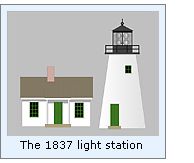 The contract for the new station's
construction was awarded to Jeremy Hixon Sr. and his son, and they
arrived at Michigan City with a work crew and materials late that
Spring. Over the summer of 1837, Hixon's crew erected a brick tower with
a diameter of 14 feet 7 inches at the base, tapering to a diameter of 6'
11' below the gallery. With its massive walls tapering in thickness from
44' inches at the foundation to 28" in thickness at their
uppermost, the tower was capped by a stone gallery floor, and an iron
lantern with 18 glass panes on each of its eight sides erected at the
gallery center. Capped by an iron pyramid roof with a copper ventilator,
the lantern was outfitted with an array of four Lewis patent lamps
equipped with 14" silvered reflectors. A short distance shoreward
from the tower, a 1-½ story brick dwelling standing 34' by 20 feet in
plan and containing five rooms was erected, and covered with a shingled
roof. The dwelling was erected over a stone cellar in one end of which a
plaster-lined brick cistern was installed to hold drinking water, either
filled with rain water diverted from the roof or from water carried from
the lake in buckets. A separate 14' by 16' summer kitchen erected a
short distance behind the dwelling completed the station's complement of
structures. To render the structures as visible as possible, all of the
station structures were given multiple coats of whitewash, which was
reported to be "dazzling in its whiteness." Edmund B Harrison
was appointed as the first keeper of the Michigan City Lighthouse, and
first appears in district payroll records at the station on September
12, and likely climbed the tower to exhibit the new light for the first
time soon thereafter. The contract for the new station's
construction was awarded to Jeremy Hixon Sr. and his son, and they
arrived at Michigan City with a work crew and materials late that
Spring. Over the summer of 1837, Hixon's crew erected a brick tower with
a diameter of 14 feet 7 inches at the base, tapering to a diameter of 6'
11' below the gallery. With its massive walls tapering in thickness from
44' inches at the foundation to 28" in thickness at their
uppermost, the tower was capped by a stone gallery floor, and an iron
lantern with 18 glass panes on each of its eight sides erected at the
gallery center. Capped by an iron pyramid roof with a copper ventilator,
the lantern was outfitted with an array of four Lewis patent lamps
equipped with 14" silvered reflectors. A short distance shoreward
from the tower, a 1-½ story brick dwelling standing 34' by 20 feet in
plan and containing five rooms was erected, and covered with a shingled
roof. The dwelling was erected over a stone cellar in one end of which a
plaster-lined brick cistern was installed to hold drinking water, either
filled with rain water diverted from the roof or from water carried from
the lake in buckets. A separate 14' by 16' summer kitchen erected a
short distance behind the dwelling completed the station's complement of
structures. To render the structures as visible as possible, all of the
station structures were given multiple coats of whitewash, which was
reported to be "dazzling in its whiteness." Edmund B Harrison
was appointed as the first keeper of the Michigan City Lighthouse, and
first appears in district payroll records at the station on September
12, and likely climbed the tower to exhibit the new light for the first
time soon thereafter.
On November 3, of the following year,
Lieutenant James To Homans, the Inspector of lights of the northwestern
lakes, arrived in Michigan City, and found the station to be in good
order, and carefully attended. However, the life of a lightkeeper was
evidently not to Harrison's liking, as he resigned his position after
four years to be replaced by James Towner on October 26, 1841. For
reasons that have yet to be determined, Towner resigned in 1844, and was
succeeded by his wife Harriet on March 21, 1844.
Little mention is made of the Michigan
City Light station in government reports for the next five years until
Superintendent Henry B Miller arrived at the station in 1849, and
ordered that brickwork on the tower be re-pointed and the buildings
re-coated with whitewash. Miller returned on July 22 of the following
year, and observed that approximately half of the fence around station
needed replacement as the posts were rotting. He also left materials and
instructions to Mrs. Towner to have the shutters painted at a total cost
not to exceed $10.00. With the formation of the new Lighthouse Board in
1853, one of the new Board's major initiatives was to replace all of the
old Lewis Patent lamp systems with the far superior French Fresnel-style
lens arrays. To this end, the Lewis lamps were removed from the lantern
in 1857 and replaced by a fixed white Sixth Order Fresnel
lens.
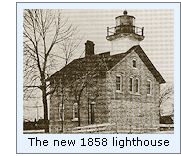 As was the case with most of the early
Great Lakes lighthouses built under the Pleasonton Administration, the
design, construction and materials used in building the Michigan City
light were of low quality, and by 1858, it was clear that the old 1837
structure had deteriorated to a point that it no longer served as an
effective aid to navigation to the increasing volume of maritime traffic
seeking entry into Trail Creek, and plans were underway to replace the
aging light with a new structure, Rather than incur the costs of
undertaking a completely new design for the station, an existing set of
plans were used, to which stations would also be built at Grand
Traverse and Port
Washington, among others. To this end, a work crew arrived at
the station, and over the 1858 navigation season a 1-½ story dwelling
standing 30 feet by 32 feet and containing seven rooms was erected over
a full Joliet stone cellar. Centered at the north gable end of the
shingled roof, a six-foot square white painted wood tower was erected
and capped with a 6' diameter nine-sided iron lantern equipped with a
new fixed white Fifth Order Fresnel lens which was visible for a
distance of 15 miles in clear weather. As was the case with most of the early
Great Lakes lighthouses built under the Pleasonton Administration, the
design, construction and materials used in building the Michigan City
light were of low quality, and by 1858, it was clear that the old 1837
structure had deteriorated to a point that it no longer served as an
effective aid to navigation to the increasing volume of maritime traffic
seeking entry into Trail Creek, and plans were underway to replace the
aging light with a new structure, Rather than incur the costs of
undertaking a completely new design for the station, an existing set of
plans were used, to which stations would also be built at Grand
Traverse and Port
Washington, among others. To this end, a work crew arrived at
the station, and over the 1858 navigation season a 1-½ story dwelling
standing 30 feet by 32 feet and containing seven rooms was erected over
a full Joliet stone cellar. Centered at the north gable end of the
shingled roof, a six-foot square white painted wood tower was erected
and capped with a 6' diameter nine-sided iron lantern equipped with a
new fixed white Fifth Order Fresnel lens which was visible for a
distance of 15 miles in clear weather.
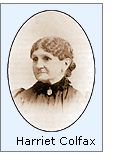 Three years after construction of the
new building, Harriet E. Colfax was appointed as Keeper. Harriet was
born in Ogdensburg, New York in 1824, and had moved to Michigan City
with her brother in the early 1850's. Working as a teacher in one of the
local schools, Harriet established a strong friendship with Miss Ann C
Hartwell, who had also grown up in Ogdensburg and had also found
employment as a teacher in Michigan City. Harriet's brother founded a
local newspaper known as The Transcript, where Harriet soon ended up
working as a typesetter. However, after her brother's failing health
forced him to sell the Transcript, Harriet found herself out of work,
and upon hearing that Keeper John Clarkson was resigning as keeper of
the Michigan City Light, determined that she would seek appointment as
Clarkson's replacement. A lady of petite stature, and by all accounts
somewhat frail, Harriet appears to have been a person wholly unsuited to
the hard working rigors of life as a light keeper. Thus, it is easy to
speculate that her cousin Congressman Schuyler Colfax might have applied
some political pressure to ensure Harriet's appointment as keeper on
March 19, 1861. Regardless of the circumstances surrounding her
appointment, Harriet quickly put to rest any concerns about her fitness
for duty, and quickly proved herself to be a dedicated and hard working
steward of the Michigan City light. With her responsibilities limited to
tending the single building an light, Harriet was not provided with an
assistant, however it appears that her longtime friend Ann Hartwell also
took up residence in the lighthouse, and likely served to help with
daily station chores. Three years after construction of the
new building, Harriet E. Colfax was appointed as Keeper. Harriet was
born in Ogdensburg, New York in 1824, and had moved to Michigan City
with her brother in the early 1850's. Working as a teacher in one of the
local schools, Harriet established a strong friendship with Miss Ann C
Hartwell, who had also grown up in Ogdensburg and had also found
employment as a teacher in Michigan City. Harriet's brother founded a
local newspaper known as The Transcript, where Harriet soon ended up
working as a typesetter. However, after her brother's failing health
forced him to sell the Transcript, Harriet found herself out of work,
and upon hearing that Keeper John Clarkson was resigning as keeper of
the Michigan City Light, determined that she would seek appointment as
Clarkson's replacement. A lady of petite stature, and by all accounts
somewhat frail, Harriet appears to have been a person wholly unsuited to
the hard working rigors of life as a light keeper. Thus, it is easy to
speculate that her cousin Congressman Schuyler Colfax might have applied
some political pressure to ensure Harriet's appointment as keeper on
March 19, 1861. Regardless of the circumstances surrounding her
appointment, Harriet quickly put to rest any concerns about her fitness
for duty, and quickly proved herself to be a dedicated and hard working
steward of the Michigan City light. With her responsibilities limited to
tending the single building an light, Harriet was not provided with an
assistant, however it appears that her longtime friend Ann Hartwell also
took up residence in the lighthouse, and likely served to help with
daily station chores.
By 1868, there were a number of leaks
where the tower was integrated into the shingled roof, and the following
year a crew arrived at the station to undertake the necessary repairs.
Over the years, a number of squatters had moved onto the lighthouse
property and erected ramshackle shacks in the area. It is likely that
Colfax brought this to the attention of the District Inspector during
his visits to the station, as the 1869 annual report contained a
statement that "Measures should be taken to remove intruders who
have settled upon the reservation."
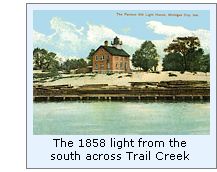 By the 1870's it was clear that the
short timber piers erected some 30 years previous were wholly
unsuccessful, as even with frequent dredging, the depth across the bar
at the river mouth was frequently reported to be as shallow as 2 ½ feet
at times, with entry still blocked to vessels except those of the
shallowest draft, and the Army Corps of Engineers again returned to
Michigan City to begin extending the piers at the river mouth in 1871.
To guide the way between the lengthened piers, a timber frame pierhead
beacon was erected on the outer end of the east pier on November 20,
1871. With the increased workload resulting from responsibility for two
lights at the station, Hayward Soloman was appointed as Harriet's
assistant, reporting for duty on November 29. By the 1870's it was clear that the
short timber piers erected some 30 years previous were wholly
unsuccessful, as even with frequent dredging, the depth across the bar
at the river mouth was frequently reported to be as shallow as 2 ½ feet
at times, with entry still blocked to vessels except those of the
shallowest draft, and the Army Corps of Engineers again returned to
Michigan City to begin extending the piers at the river mouth in 1871.
To guide the way between the lengthened piers, a timber frame pierhead
beacon was erected on the outer end of the east pier on November 20,
1871. With the increased workload resulting from responsibility for two
lights at the station, Hayward Soloman was appointed as Harriet's
assistant, reporting for duty on November 29.
In 1880, the dwelling and outbuildings
were repaired, the tower and lantern were painted, and a 320-foot wooden
fence was erected around the lighthouse grounds. Two years later, sand
drifts, which had built up around the station buildings were leveled,
and the fence on the north and west sides was replaced with a tight
board fence to serve as a wind break to help stem future drifting. A
well was dug and lined with brick and connected to a hand pump in the
kitchen by an iron pipe.
While Colfax had likely appreciated the
five assistants who had been assigned to the station to work with her
over the past ten years, the assistant's position was abolished in 1882,
likely as a district cost cutting measure, and Harriet was forced to
make the grueling trip out to the pierhead light twice a night to tend
the light.
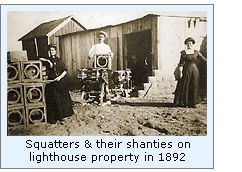 By 1892, there had been little
improvement in the situation with squatters on the lighthouse property,
and measures were taken to evict them and their shanties were removed.
Since the establishment of the original light 63 years previous, lamp
oil had been stored in the cellar beneath the dwelling. However, with a
change to the significantly more volatile kerosene, a number of
devastating dwelling fires were experienced, and beginning late in the
1880's the Lighthouse Board began building separate oil storage
buildings at all US light stations. To this end, a work crew and 6,000
bricks were delivered at the station in 1894, and a 350-gallon capacity
brick oil storage building standing 7' by 12' in plan was erected 50
feet southeast of the dwelling. By 1892, there had been little
improvement in the situation with squatters on the lighthouse property,
and measures were taken to evict them and their shanties were removed.
Since the establishment of the original light 63 years previous, lamp
oil had been stored in the cellar beneath the dwelling. However, with a
change to the significantly more volatile kerosene, a number of
devastating dwelling fires were experienced, and beginning late in the
1880's the Lighthouse Board began building separate oil storage
buildings at all US light stations. To this end, a work crew and 6,000
bricks were delivered at the station in 1894, and a 350-gallon capacity
brick oil storage building standing 7' by 12' in plan was erected 50
feet southeast of the dwelling.
With the Army Corps of Engineers
engaged in constructing a breakwater on the east side of the river mouth
in 1904, the Lighthouse Board began planning for the establishment of a
combined first-class fog and light tower at its outer end in 1904. At 80
years of age, Harriet retired as keeper of the Michigan City Light after
43 years of faithful service to her station. Her love of the station is
evident in her entry in the station log book on October 8 in which she
wrote "Sold household effects preparatory to vacating dear old Lt.
House." Thomas J. Armstrong, who had been serving as keeper of the
South Manitou Light Station for the past ten years was transferred in as
the station's new keeper, and Harriet departed her "dear"
station on October 13, 1904. Harriet passed away five months later on
April 16, 1905.
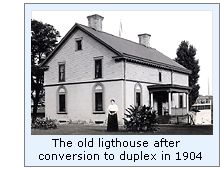 Simultaneous with construction of the
new fog signal building, the old lighthouse building underwent
considerable modification to convert it into a triplex dwelling, with 4
rooms for the head keeper and 3 rooms for each of his two assistants. As
part of the reconfiguration, porches were added on each side of the
building and the bricks of the upper floor were covered with dark green
painted shingles. A coal shed and double privy were erected to the rear
of the station and concrete walks poured to connect the station
buildings. The Fifth Order lens was removed from the lantern on October 20, and
reestablished in the lantern atop the new breakwater fog signal
building, from whence it was first exhibited on the evening of October
20, 1904. No longer serving any purpose, the square wooden tower and
lantern atop the dwelling were removed, and the building re-roofed. Simultaneous with construction of the
new fog signal building, the old lighthouse building underwent
considerable modification to convert it into a triplex dwelling, with 4
rooms for the head keeper and 3 rooms for each of his two assistants. As
part of the reconfiguration, porches were added on each side of the
building and the bricks of the upper floor were covered with dark green
painted shingles. A coal shed and double privy were erected to the rear
of the station and concrete walks poured to connect the station
buildings. The Fifth Order lens was removed from the lantern on October 20, and
reestablished in the lantern atop the new breakwater fog signal
building, from whence it was first exhibited on the evening of October
20, 1904. No longer serving any purpose, the square wooden tower and
lantern atop the dwelling were removed, and the building re-roofed.
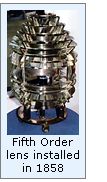 With
the creation of a city park around the harbor area in 1907, the Michigan
City Board of Public Works received permission from the federal
government to occupy and beautify most of the lighthouse property with
the exception of the area immediately surrounding the dwelling. the After the US Coast Guard assumed
responsibility for the nation's aids to navigation in 1939, crews
assigned to operate the harbor lights and fog signal lived in the Coast
Guard, with the old dwelling serving at times as a private dwelling and
at times as a base of operations for the Michigan City Coast Guard
Auxiliary. After sitting vacant for a number of years during which the
venerable structure was significantly vandalized, the decision was made
to excess the property in 1960. With
the creation of a city park around the harbor area in 1907, the Michigan
City Board of Public Works received permission from the federal
government to occupy and beautify most of the lighthouse property with
the exception of the area immediately surrounding the dwelling. the After the US Coast Guard assumed
responsibility for the nation's aids to navigation in 1939, crews
assigned to operate the harbor lights and fog signal lived in the Coast
Guard, with the old dwelling serving at times as a private dwelling and
at times as a base of operations for the Michigan City Coast Guard
Auxiliary. After sitting vacant for a number of years during which the
venerable structure was significantly vandalized, the decision was made
to excess the property in 1960.
The city purchased the building in
1963, and entered into an agreement with the Michigan City Historical
Society in 1965 whereby the Society would restore the structure and
maintain it as a museum. After eight years of restoration, the museum
was opened on June 9, 1973, and since that date has remained opened to
the public every summer, staffed by a dedicated group of Society
volunteers.

Keepers of
this Light

Click here
to see a complete listing of all the keepers of the Michigan City Old
Light compiled by Phyllis L. Tag of Great Lakes Lighthouse Research.

Finding this Light

Take 421 North into Michigan City, through downtown and to the
Lakeshore. As 421 intersects with Lakeshore Drive, continue North into
the park. The old shore lighthouse museum is to the left, and the pier
light is to the east and approximately 1/4 mile further north around the
Marina.
The old lighthouse museum is open from 1.00pm until 4.00pm every day
of the week except Mondays throughout the summer season.

Reference Sources

History of Montgomery
County, Indiana. Indianapolis: A. W. Bowen & Co
History of Michigan City, Indiana, Rollo B. Oglesbee and Albert
Hale, 1908
Journals of the US House & Senate, various, 1834 - 1940
Annual reports of the Fifth Auditor of the Treasury, various, 1837 -
1852
Annual reports of the Lighthouse Board, various, 1853 - 1909
Great Lakes Light Lists, various, 1846 through 1904
Women Who Kept The Lights, J.
Candace & Mary Louise Clifford, 1993
Those Army Engineers, John W Larson, 1979
Keeper listings for this light appear courtesy of Great Lakes Lighthouse
Research
|
